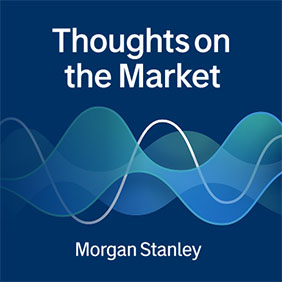Humanoids’ Insatiable Hunger for Minerals
Jun 25, 2025
Our Australia Materials Analyst Rahul Anand discusses why critical minerals may be the Achilles’ heel of humanoids as demand significantly outpaces supply amid geopolitical uncertainties.

-
 Rahul Anand
Rahul Anand
Thoughts on the Market
Listen to our financial podcast, featuring perspectives from leaders within Morgan Stanley and their perspectives on the forces shaping markets today.

Up Next
India Outperforms with High Growth and Low Volatility
Morgan Stanley’s Chief Asia Equity Strategist Jonathan Garner explains why Indian equities are our most preferred market in Asia.
Transcript
Welcome to Thoughts on the Market. I’m Jonathan Garner, Morgan Stanley’s Chief Asia Equity Strategist. Today I’ll discuss why we remain positive on India’s long-term equity story.
It’s Tuesday, the 24th of June at 9am in Singapore.
We’ve had a long-standing bullish outlook on the India economy and its stock market. In the last five years MSCI India has delivered a total return in U.S. dollars of 145 percent versus 94 percent for global equities and just 39 percent for emerging markets. Indian equities are our most preferred market within Asia for three key reasons. First, India’s superior economic and earnings growth. Second, lower exposure to trade tariffs. And third, a strong domestic investor base. And all of this adds up to structural outperformance not just in Asia but indeed globally, and with significantly lower volatility than peer group markets.
So let’s dive deeper. To start with – the macroeconomic backdrop. We expect India to account for 20 percent of overall incremental global GDP growth in the coming decade. Manufacturing competitiveness is improving thanks to bolstered infrastructure in power, ports, roads, freight transport systems as well as investments in social infrastructure such as water, sewage and hospitals.
Additionally, India's growing middle class offers market opportunities to companies across many product categories. There’s robust domestic consumption, a strong investment cycle led by public and private capital expenditure and continuing structural reforms, including in the legal sphere. GDP growth in the first quarter was more than 7 percent and our team expects over 6 percent in the medium term, which would be by far the highest of the major economies
Furthermore, we continue to expect robust corporate earnings growth. Since the end of COVID, MSCI India has delivered around 12 percent per annum [U.S.] dollar earnings per share growth versus low single digits for Emerging Markets overall. And we forecast 14 percent and 16 percent over the next two fiscal years. Growth drivers in the short term include an emerging private CapEx cycle, re-leveraging of corporate balance sheets, and a structural rise in discretionary consumption – signaling increased business and consumer confidence, after last year’s elections.
Another key reason that we’re positive on India currently is its lower-than-average vulnerability to ongoing trade and tariff disputes between the U.S. and its trade partners. Exports of goods to the U.S. amount to only 2 percent of India’s GDP versus, for example, 10 percent in Thailand or 14 percent in Taiwan. And India’s total goods exports are only around 12 percent of GDP. Moreover, for the time being, India’s very large services sector’s exports are not exposed to tariff actions, and are actually early beneficiaries of AI adoption.
Finally, India’s strong individual stock ownership means that there’s persistent retail buying, which underpins the equity market. Systematic Investment Plan (SIP) flows driven by a young urbanizing population are making new highs, and in May amounted to over U.S.$3 billion. They provide consistent capital inflows. That means that this domestic bid on stocks is unlikely to fade anytime soon.
This provides a strong foundation for the market and supports valuations which are slightly above emerging market averages. It also means that its market beta to global equities are low and falling, approximately 0.4 versus 1.1 ten years ago. And price volatility is well below other emerging markets. All told, making India an attractive play in volatile times.
Thanks for listening. If you enjoy the show, please leave us a review wherever you listen and share Thoughts on the Market with a friend or colleague today.

Why Stocks Can Be Resilient Despite Geopolitical Risk
Our CIO and Chief U.S. Equity Strategist Mike Wilson explains why investors have largely remained calm amid recent developments in the Middle East.
Transcript
Welcome to Thoughts on the Market. I'm Mike Wilson, Morgan Stanley’s CIO and Chief U.S. Equity Strategist. Today on the podcast I’ll be discussing how to think about the tensions in the Middle East for U.S. equities.
It's Monday, June 23rd at 11:30am in New York.
So, let’s get after it.
Over the weekend, the United States executed a surprise attack on Iran’s nuclear enrichment facilities. While the extent of the damage has yet to be confirmed, President Trump has indicated Iran’s nuclear weapon development efforts have been diminished substantially, if not fully. If true, then this could be viewed as a peak rate of change for this risk. In many ways this fits our overall narrative for U.S. equities that we have likely passed the worst for many risks that were weighing on stocks in the first quarter of the year. Things like immigration enforcement, fiscal spending cuts, tariffs and AI CapEx deceleration all contributed to dragging down earnings forecasts.
Fast forward to today and all of these items have peaked in terms of their negative impact, and earnings forecasts have rebounded since Mid-April. In fact, the rebound in earnings revision breadth is one of the sharpest on record and provides a fundamental reason for why U.S. stocks have been so strong since bottoming the week of April 7th. Add in the events of this past weekend and it makes sense why equities are not selling off this morning as many might have expected.
For further context, we looked at 23 major geopolitical events since 1950 and the impact on stock prices. What we found may surprise listeners, but it is a well understood fact by seasoned investors. Geopolitical shocks are typically followed by higher, not lower equity prices, especially over 6 to12 months. Only five of the 23 outcomes were negative. And importantly, all the negative outcomes were accompanied by oil prices that were at least 75 percent higher on a year-over-year basis. As of this morning, oil prices are down 10 percent year-over-year and this is after the actions over the weekend. In other words, the conditions are not in place for lower equity prices on a 6 to12 month horizon.
Having said that, we continue to recommend large cap higher quality equities rather than small cap lower quality names. This is mostly a function of sticky long term interest rates and the fact that we remain in a late cycle environment in which the Fed is on hold. Should that change and the Fed begin to signal rate cuts, we would pivot to a more cyclical areas of the market.
Our favorite sectors remain Industrials which are geared to higher capital spending for power and infrastructure, Financials which will benefit from deregulation this fall and software stocks that remain immune from tariffs and levered to the next area of spending for AI diffusion across the economy. We also like Energy over consumer discretionary as a hedge against the risk of higher oil prices in the near term.
Thanks for tuning in; I hope you found today's episode informative and useful. Let us know what you think by leaving us a review; and if you find Thoughts on the Market worthwhile, tell a friend or colleague to try it out!

Sign up to get Morgan Stanley’s Five Ideas newsletter delivered weekly to your inbox.
Subscribed!
Thank you for subscribing to our blog newsletter. Stay tuned to hear about Morgan Stanley ideas!




